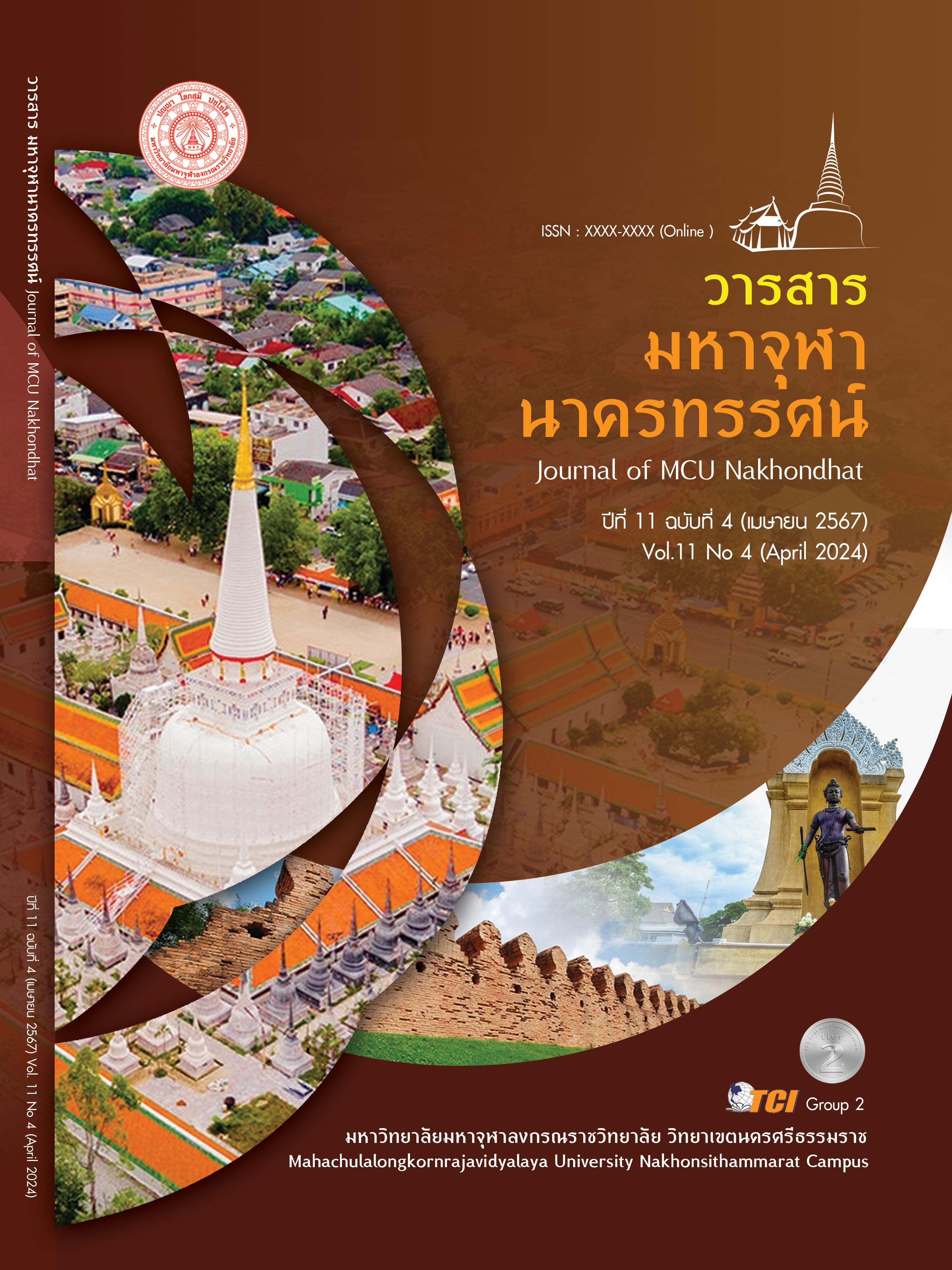EXPOSURE TO ANIME, ATTITUDE AND MORAL AWARENESS AMONG GENERATION Y VIEWERS
Main Article Content
Abstract
This study intends to 1) Investigate the exposure to animes 2) Investigate the attitudes toward animes, 3) Investigate moral awareness among viewers from Generation Y 4) Explore the relationships between the exposure to animes, attitudes, and moral awareness among viewers from Generation Y. Employing a quantitative research paradigm, this survey involved 400 participants aged 23 - 42 years who were selected through proportional stratified sampling. Descriptive and inferential statistics were utilized to analyze data. The inferential statistics used to test hypotheses were One-Way ANOVA, Pearson Correlation Coefficient and Post - Hoc Comparison by Scheffe if there were differences. Results revealed that demographic characteristics concerning gender and education levels did not influence exposure, but there were differences based on participants’ occupations. The average viewing period of most participants was 5 hours/week. They had the highest attitude toward contents that reflect the morality of responsibility, aligning with their highest moral awareness in the aspect of responsibility. Regarding the relationships among variables, there was a significant correlation between exposure to animes and attitudes toward them at the 0.05 level. The correlation was positive. Moreover, the exposure to animes was significantly related to moral awareness at 0.05 level with a positive correlation. Attitudes toward animes also demonstrated a significant relationship with participants’ moral awareness at the 0.05 level with positive correlation
Article Details

This work is licensed under a Creative Commons Attribution-NonCommercial-NoDerivatives 4.0 International License.
References
กาญจนา แก้วเทพ. (2556). กระบวนทัศน์ใหม่ของสื่อสารศึกษาไทย. ใน รายงานการวิจัย. สำนักงานคณะกรรมการส่งเสริมวิทยาศาสตร์ วิจัยและนวัตกรรม.
ขจิตขวัญ กิจวิสาละ. (2564). ศาสตร์การเล่าเรื่องในสื่อสารศึกษา. วารสารศาสตร์, 14(3), 9-85.
ชวรินทร์ ศิลปสุวรรณ. (2558). การเรียนรู้ของเยาวชนไทยเกี่ยวกับวัฒนธรรมญี่ปุ่นผ่านสื่อการ์ตูนญี่ปุ่น. ใน วิทยานิพนธ์มหาบัณฑิต สาขาวิชานิเทศศาสตร์. มหาวิทยาลัยกรุงเทพ.
ชิโนรส ถิ่นวิไลสกุล. (2555). ผลกระทบของงานโฆษณาที่มีต่อการเรียนรู้ของเยาวชน กรณีศึกษา : เยาวชนชุมชนสวนอ้อย. ใน รายงานการวิจัย. มหาวิทยาลัยราชภัฏสวนสุนันทา.
เญยยา จิตรใจเย็น. (2565). การรับรู้วัฒนธรรม และองค์ประกอบการเล่าเรื่องที่ดึงดูดการชมอนิเมะญี่ปุ่น. ใน วิทยานิพนธ์ศิลปศาสตรมหาบันฑิต สาขานิเทศศาสตร์และสารสนเทศ. มหาวิทยาลัยเกษตรศาสตร์.
ณิชาภัทร ตั้นจัด. (2563). การเปิดรับชมอนิเมะผ่านวิดีโอสรีมมิ่งกับการรับรู้วัฒนธรรมสมัยนิยมของญี่ปุ่น. ใน การค้นคว้าอิสระวารสารศาสตรมหาบัณฑิต สาขาวิชาการบริหารสื่อสารมวลชน. มหาวิทยาลัยธรรมศาสตร์.
ไทยรัฐออนไลน์. (2564). สำรวจปรากฏการณ์ Anime Boom : ทำไม ‘อนิเมะญี่ปุ่น’ จึงอยู่ยั้งยืนยง. เรียกใช้เมื่อ 30 สิงหาคม 2566 จาก https://www.thairath.co.th/entertain/inter/2087431
ธนบดี วรวงศ์เธอ. (2565). ปัจจัยจากแรงจูงใจของการ์ตูนญี่ปุ่นที่มีต่อผลความสำเร็จในการประกอบอาชีพของผู้คนในเจนเนอร์เรชันวายในประเทศไทย. ใน วิทยานิพนธ์การจัดการมหาบัณฑิต สาขาการจัดการ. มหาวิทยาลัยมหิดล.
นรงค์ เติมอินทร์. (2550). หนังสือการ์ตูนที่วัยรุ่นไทยในชนบทชอบอ่านมากที่สุด พ.ศ. 2550 : กรณีศึกษาอำเภอกระนวน. ใน การศึกษาอิสระศึกษาศาสตรมหาบัณฑิต สาขาวิชาสังคมศึกษา. มหาวิทยาลัยขอนแก่น.
นิพนธ์ คุณารักษ์. (2552). ภาษาภาพยนตร์: องค์ประกอบของภาพยนตร์. วารสารศิลปกรรมศาสตร์ มหาวิทยาลัยของแก่น, 1(1), 20-29.
ปรมะ สตะเทวิน. (2540). หลักนิเทศศาสตร์. กรุงเทพมหานคร: ภาพพิมพ์.
ปารณพัฒน์ แอนุ้ย. (2560). การเรียนรู้ทางสังคมของแฟนภาพยนตร์การ์ตูนญี่ปุ่นชุด มาสค์ไรเดอร์. ใน วิทยานิพนธ์วารสารศาสตรมหาบัณฑิต สาขาวิชาสื่อสารมวลชน. มหาวิทยาลัยธรรมศาสตร์.
ลงทุนแมน. (2566). ญี่ปุ่น ดูดเงินเข้าประเทศ 300,000 ล้าน ด้วย อานิเมะ. เรียกใช้เมื่อ 30 สิงหาคม 2566 จาก https://www.longtunman.com/43850
ศุภนิดา จันทร์กระจ่าง. (2563). การเปิดรับทัศนคติ และพฤติกรรมการตอบสนองของผู้บริโภคต่อการสื่อสารที่ขับเคลื่อนด้วยระบบอัลกอริทึมและข้อมูลส่วนบุคคล สำหรับสินค้าที่เป็นมิตรต่อสิ่งแวดล้อมบนเฟซบุ๊ก. ใน วิทยานิพนธ์นิเทศศาสตรมหาบัณฑิต สาขาวิชานิเทศศาสตร์. จุฬาลงกรณ์มหาวิทยาลัย.
สุชาดา ปราบมีชัย และสมสมร เรืองวรบูรณ์. (2560). ผลของสื่อแอนิเมชั่น ต่อความรู้และพฤติกรรมการดูแลตนเองของเด็กวัยเรียนโรคธาลัสซีเมีย. วารสารพยาบาลกระทรวงสาธารณสุข, 27(2), 96-109.
ETDA. (2022). ETDA reveals that Gen Y reclaims the throne, uses the internet the most, almost 8 hours a day, most popular, watch LIVE COMMERCE, civil servants and government officials. Win every career, use the internet almost 12 hours a day. Retrieved July 16, 2023, from https://www.etda.or.th/th/pr-news/iub2022.aspx
Fishbein, M. & Ajzen, I. (1975). Belief, Attitude, Intention and Behavior: An Introduction to Theory and Research. Reading, MA: Addison-Wesley.
Hilgard, E. R. & Bower, H. (1981). Theories of learning. (5th ed.). New Jersey: Prentice - Hall.like -to - watch - cartoons.
MGR Online. (2022). Japan model birth "Blue Lock Buriram" Association joins hands with Newin Create new blood players Following themanga. Retrieved August 20 , 2023, from https://mgronline.com/sport/detail/9650000116097
Mission To The Moon. (2023). As an adult, why do you still watch cartoons? About small happiness of being an adult. Retrieved March 29, 2024, from https://missiontothemoon.co/psychology-why-adults-like-to-watch-cartoons/
Schramm, W. (1973). Channels and Audiences. In Handbook of communication. Chicago: Rand Mcnally College Publishing.
The MATTER. (2017). “What can you do if you like cartoons?” From dream to reality Cartoon people's life path. Retrieved August 15 , 2023, from https://thematter.co/entertainment/reading-too-much-cartoon-may-lead-you-to-a-job/20859


